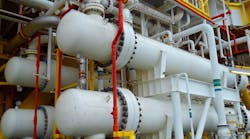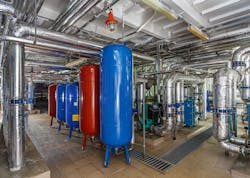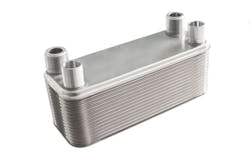One of the most commonly used and vital pieces of processing equipment in the industrial sector is the OEM exchanger. While exchangers efficiently perform cooling and heating functions, the industrial sector primarily utilizes them for cooling.
When they are not operating at peak efficiency levels, exchangers may adversely affect both production rates and overall product cost per unit. Cleaning of OEM exchangers is critical to maintaining the equipment properly and should be a priority.
The Basics of OEM Exchangers
A heat exchanger's primary function is to heat or cool elements by transferring or exchanging heat from one medium to another. The heat may be in either gas or liquid form. Steam condensers, chillers, and air conditioners depend on exchangers to function correctly.
Each type of heat exchanger commonly found today serves a distinct purpose.
Shell and tube exchangers contain packs of tubes within "shells." Gas or fluid requiring treatment flows through a series of tubes.
One set is the input, and the other is the output. The temperature of the gas or liquid entering the input will output the exact opposite.
Plate heat exchangers rely on thin aluminum sheets instead of tubes. They function in the same way as shell and tube models, but their large surface area makes them more efficient for transferring heat.
Adiabatic wheel exchangers use a thermodynamic process, which occurs without any heat gain or loss. In order to function as a heat exchanger, the adiabatic wheel stores heat until its eventual release.
Regenerative exchangers are an environmentally friendly option for conserving energy. They operate on a continuous cycle, running from input to output and regenerating the output to become the next infusion of input.
Fouling Types — How Heat Exchangers Get Dirty
A chronic operating problem significantly and negatively impacting operational efficiency in industrial processing is the fouling of heat exchangers. The broad definition of fouling is unwanted materials depositing and accumulating on external and internal processing equipment surfaces.
Examples of common culprits include insoluble salts, algae, suspended solids, and scale. While there are many different types of fouling, four are seen most often—deposition, biological, chemical, and corrosion.
Deposition fouling occurs when fluid velocity falls below critical levels, causing the particles contained within to settle on surfaces. The proper design of the system and vertical mounting can reduce fouling of this type.
Biological fouling occurs when organisms within the fluid grow and deposit onto exchanger surfaces. The material choice provides the best prevention of biological fouling. For example, non-ferrous brasses kill specific organisms, reducing the threat to the exchanger system.
Chemical fouling occurs when internal fluid changes result in the deposition of a fouling layer on the surface of tubes. Most notably, this is seen as the formation of scale, which is caused when increasing temperature creates insoluble salt deposits on heating elements. The system design does not affect chemical fouling, but it can be reduced by carefully controlling the temperature of the tube walls that encounter fluids.
Corrosion fouling occurs as the result of corrosive product layers building upon tube surfaces. As these layers continue to build, their high-thermal resistance noticeably reduces operating efficiency. Choosing corrosion-resistant construction materials during the design stage can minimize these effects.
By the Numbers
In industrialized countries, fouling costs an estimated $4.5 million annually, or roughly 0.30% of their total GNP. Maintenance costs for processing plants have about 15% attributed to boilers and OEM exchangers, and of this 15%, approximately 7.5% is caused by fouling.
Heat exchanger fouling costs encompass plugged or corroded equipment replacement, increased fuel consumption, production losses due to decreased efficiency or forced and planned shutdowns caused by fouling, and cleaning and maintenance methods. The average cost to clean each exchanger is about $45,000.
When to Clean OEM Exchangers
Well-established heat exchanger cleaning time protocols exist in industries requiring high sanitation, such as pharmaceutical, dairy, and food processing. Depending on the product, cleanings are done based on schedules set daily, weekly, and during product batch changes.
Industries with lower sanitation level needs may regulate their cleaning schedules based on the cost of a maintenance downtime day vs. hourly loss fouling costs over time. By determining when it is best and least costly for complete downtime to occur, managers are better able to implement a fixed schedule for preventative cleaning and maintenance.
The way that companies view scheduled cleaning and maintenance days has changed with the passage of time. Where once it was normal to clean exchangers faithfully once or twice per year, the time between cleanings today is extended to anywhere between four and ten years, depending on the type of exchanger and its use.
As research and development produce more technologically advanced equipment, the reliability of exchangers equals a substantial reduction in loss days due to cleaning. The result is fewer dollars lost from production shutdowns.
How to Clean OEM Exchangers
There are several different options available for cleaning heat exchangers. Automated clean-in-place (CIP) systems have the greatest efficiency because sanitizing and cleaning take place without the need to disconnect the exchanger system. CIP is effective for high-sanitation requirements.
Mechanical cleaning takes place when the machinery is offline, which works well in instances where fouling is too severe for other methods. Tools vary depending on the deposits requiring removal. For example, light silt is best removed by molded plastic cleaners.
Tube surfaces that are finned or indented spirally respond well to brushes, as do some microbial deposits and silt. Brushes are effective on epoxy-coated tubes, or those with thin metal inserts. Where deposits are harder than brushes can handle, various designs of metal cleaners are available, as are cleaners that are acid- or calcite-based.
High-pressure water jet cleaning is one of the most common exchanger cleaning methods. High-pressure forces water through a small nozzle, cleaning surfaces of various deposits, scaling, rust, and debris. The water then forces the waste to be washed away.
Chemical cleaning is another popular and effective method. Being highly specialized and targeted to the exact deposit type saves time, although the cost is significantly higher than other methods. Once the chemicals have dissolved the fouling, the system needs to be thoroughly rinsed to prevent product contamination with chemical residue.
Cleaning Advances for OEM Exchangers
Fouling is not a new problem, and there is consistent research into ways to reduce and clean it. Scientific advances continue to offer solutions for cleaning that are increasingly efficient and cost-effective.
Darts are the most innovative and interesting advance. With the use of air or water, darts are shot into the exchanger, directly targeting the deposit. They are available in various sizes and "strengths." Their usages vary from light cleaning duties of silt and mud to the extreme cleaning of difficult-to-remove scale and other hard deposits.
Final Thoughts
OEM exchangers are essential for industrial applications, so it is vital they receive plenty of TLC. Learning to recognize the early signs of fouling and how to deal with it is the first step to ensuring minimum revenue loss.
As thermal science advances, so will the options for cleaning and maintenance. Keeping up with the newest technology for your industry will make sure downtime occurs only when absolutely required and on a schedule acceptable to your business.
This piece was contributed by David Holland, the vice president of Mahan's Thermal Products. Mr. Holland has a degree in mechanical engineering and an extensive background in general contracting and mechanical contracting, as well as years of experience in the design and construction of mechanical systems and controls.












